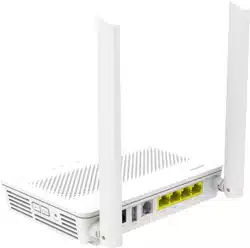Loading ...
Loading ...
Loading ...

1/13/2020 HedEx Startpage
localhost:7890/printtopics.html?time=Mon Jan 13 2020 13:54:48 GMT+0100 (Central European Standard Time) 14/86
Parameter Description
802.1p policy Indicates the 802.1p priority policy.
Use specified value: indicates that a specified priority value is used. If you select this option, you need
to set the 802.1p parameter.
Copy from IP precedence: indicates that the priority is copied from the ToS field in the IP header of the
user-side packets. If the received packet is not an IP packet or the packet does not carry the 802.1p
priority, the default 802.1p priority is used. If you select this option, you need to set the Default 802.1p
parameter.
Dscp Pbit Mapping: indicates the priority displayed in the DSCP to 802.1p mapping table. The DSCP
field is in the IP header of the user-side packets. If the received packet is not an IP packet or the packet
does not carry the 802.1p priority, the default 802.1p priority is used. If you select this option, you need
to set the Default 802.1p parameter.
MTU Indicates the maximum transmission unit (MTU) of IPoE packets. This parameter needs to be set only when
Encapsulation Mode is set to IPoE.
MRU Indicates the maximum receive unit (MRU) of PPPoE packets. This parameter needs to be set only when
Encapsulation Mode is set to PPPoE.
User name Indicates the user name that is used for PPPoE dialup. This user name must be the same as that configured on the
BRAS. This parameter needs to be set only when Encapsulation Mode is set to PPPoE.
Password Indicates the password that is used for PPPoE dialup. This password must be the same as that configured on the
BRAS. This parameter needs to be set only when Encapsulation Mode is set to PPPoE.
Enable LCP detection This parameter needs to be set only when Encapsulation Mode is set to PPPoE.
If you select this option, the LCP detection function is enabled. When the local LCP request times out
and no response is received, the system will detect LCP requests from the peer and considers the link
normal if the LCP request is detected.
If you do not select this option, the LCP detection function is disabled. When the local LCP request
times out and no response is received, the system does not detect LCP requests from the peer and
considers the link abnormal.
Binding options Used to bind the WAN interface to the LAN port or to the wireless SSID.
NOTE:
Before setting the binding options, set the work mode of the LAN port to route or set the wireless SSID. The binding options
can be set only after the work mode or wireless SSID is successfully set. For details, see Layer 2/3 Port Configuration, 2.4G
Basic Network Settings and 5G Basic Network Settings.
IPv4 Information
IP Acquisition Mode Indicates the mode of obtaining an IPv4 address on the ONT. It can be set to DHCP, Static, or PPPoE.
If the encapsulation mode is set to IPoE, this parameter can be set to DHCP or Static. If the encapsulation mode
is set to PPPoE, this parameter can be set to only PPPoE.
In DHCP mode, the IP address is dynamically obtained.
In static mode, the IP address is set statically. You need to enter the IP address, subnet mask, IP
addresses of the active and standby DNS servers, and default gateway.
In PPPoE mode, you need to enter the user name and password.
Enable NAT Indicates whether to enable the NAT function.
NAT type Specifies the NAT type. It can be set to Port-restricted cone NAT or Full-cone NAT. This parameter is
configurable only if the NAT function is enabled.
Port-restricted cone NAT: After an internal address A is mapped to an external address B, an external
host can send packets to A by sending packets to B only if A has previously sent a packet to the host.
The source IP and port number in the message sent by the host must be the same as the destination IP
and port number in the previous message sent by A.
Full-cone NAT: After an internal address A is mapped to an external address B, any external host can
send packets to A by sending packets to B.
Dial Method Indicates the PPPoE dialup method. It can be set to Auto, Manual, or On Demand.
Multicast VLAN ID Indicates the multicast VLAN ID, ranging from 1 to 4094.
The multicast VLAN ID must be the same as the multicast VLAN ID on the OLT.
Vendor ID Sets the option 60 field on the DHCP client. The IP address can be obtained from the DHCP server only when
the option 60 field is the same as the setting on the upper-layer DHCP server. When IP Acquisition Mode is set
to DHCP, this parameter is configurable.
User ID Adds the Option 61 information to the DHCP packet for a WAN port request. This parameter is used to identify a
WAN port uniquely in a customer's network management domain. This parameter is configurable when IP
acquisition mode is set to DHCP.
IPv6 Information
Prefix Acquisition Mode Indicates the prefix acquisition mode. It can be set to DHCP-PD, Static, or None.
DHCPv6-PD: When the parameter is set to DHCPv6-PD, the BRAS assigns a prefix to the ONT in
DHCPv6 mode.
Static: When the parameter is set to Static, you need to manually enter a prefix.
None: When the parameter is set to None, no prefix is obtained.
If this parameter is set to RA or Auto in an earlier version, its value will be automatically changed to
DHCPv6-PD automatically after the version is upgraded to V300R019C00&V500R019C00.
Loading ...
Loading ...
Loading ...
